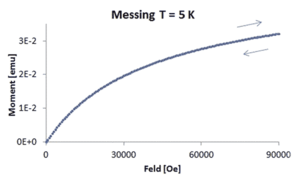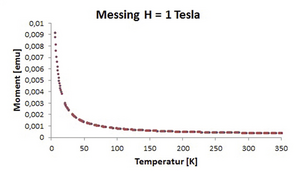News from our QD demo lab: Amagnetic is not the same as non-magnetic
In search of suitable material for low temperatures and high magnetic fields, we accidentally came across a brass alloy.
The alloy was advertised as “absolutely amagnetic” and had already been used to build an atomic clock. The material aroused our curiosity and we decided to characterize some of it.
Our PPMS-VSM measures the magnetic field dependence at different temperatures. At the same time it scans temperatures from 5 K to 350 K (approx. -268 °C to 77 °C). The material is paramagnetic.
The figure shows the magnetic moment as function of the field at 5 K and the moment as a function of temperature at a constant filed of 1 Tesla.
The temperature scan shows a significant increase of the moment at lower temperatures.
This is expected of a paramagnet as an increase in thermal energy facilitates random orientation of the magnetic dipoles.
With a sample amount of 30 mg and magnetic moments in the range of 10-3 emu (electromagnetic units), the material is not suited for our application. But is the material really amagnetic? At least, the material is not permanently magnetic, even when it is subjected to high external fields.
Do you have a material that is suitable for low temperatures and high magnetic fields and wish to characterize it in a similar way?
Are you interested in electrical properties and thermal capacity as a function of temperature or magnetic field?
Contact us for a contract measurement with our low temperature measurement system.
More information on magnetometer measurement services





